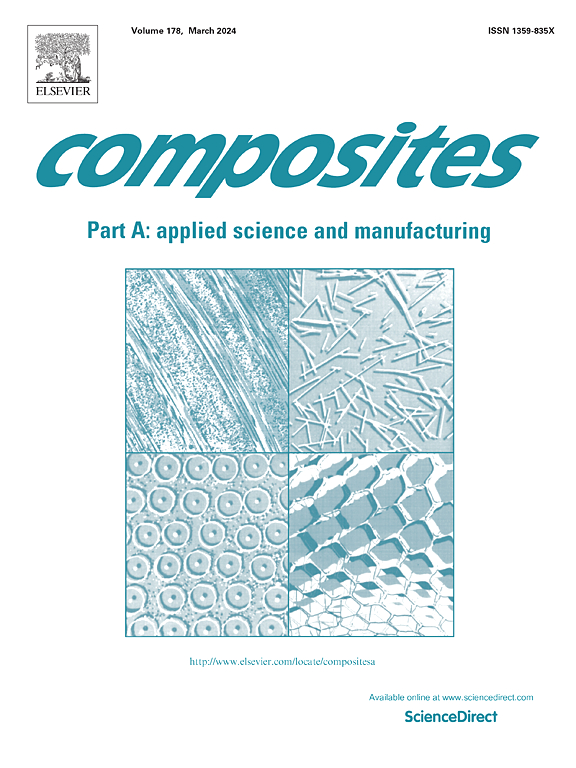Arχi-Textile 复合材料:编织结构对编织复合材料 I 型断裂能的影响
IF 8.1
2区 材料科学
Q1 ENGINEERING, MANUFACTURING
Composites Part A: Applied Science and Manufacturing
Pub Date : 2024-10-11
DOI:10.1016/j.compositesa.2024.108499
引用次数: 0
摘要
本文研究了在准静态加载条件下,编织结构对纤维增强编织聚合物复合材料裂纹扩展力学的影响。编织复合材料由织物/纺织品组成,其中的纤维以 0 度(经线)和 90 度(纬线)交织,并与聚合物基体结合在一起。通过将纤维束与单种或多种材料以不同的模式或结构进行编织,可以调整机械性能。虽然已经研究了平纹、斜纹、缎纹等均匀编织结构对平面模量和断裂能的影响,但还不清楚由子图案组合而成的图案编织(即编织结构)对这些行为的影响。我们的研究重点是确定影响包含各种子图案的拱形编织复合材料(即 Arχi (ar.kee) -Textile 复合材料)裂纹路径曲折性和传播速度的机制。通过紧凑拉伸试验,我们确定了与均匀编织相比,拱形编织图案如何在不同失效模式的相互作用下影响编织复合材料的模式 I 断裂能。结果表明,与均匀编织复合材料相比,拱形编织复合材料中子图案之间过渡区域的断裂能增加,裂纹扩展更曲折,裂纹增长阻力更大。我们还引入了三个几何参数--过渡、面积和偏斜系数--来描述子图案及其对平面内断裂能的影响。利用这些知识,我们可以为海洋和航空航天领域设计和制造更安全的轻质结构,并提高在极端负荷下的损伤耐受性。本文章由计算机程序翻译,如有差异,请以英文原文为准。
Arχi-Textile composites: Role of weave architecture on mode-I fracture energy in woven composites
This paper investigates the impact of weave architectures on the mechanics of crack propagation in fiber-reinforced woven polymer composites under quasi-static loading. Woven composites consist of fabrics/textiles containing fibers interwoven at 0 degrees (warp) and 90 degrees (weft) bound by a polymer matrix. The mechanical properties can be tuned by weaving fiber bundles with single or multiple materials in various patterns or architectures. Although the effects of uniform weave architectures, like plain, twill, satin, etc. on in-plane modulus and fracture energy have been studied, the influence of patterned weaves consisting of a combination of sub-patterns, that is, architected weaves, on these behaviors is not understood. We focus on identifying the mechanisms affecting crack path tortuosity and propagation rate in composites with architected woven textiles containing various sub-patterns, hence, Ari (ar.kee) -Textile Composites. Through compact tension tests, we determine how architected weave patterns compared to uniform weaves influence mode-I fracture energy of woven composites due to interactions of different failure modes. Results show that fracture energy increases at transition regions between sub-patterns in architected weave composites, with more tortuous crack propagation and higher resistance to crack growth than uniform weave composites. We also introduce three geometrical parameters — transition, area, and skewness factors — to characterize sub-patterns and their effects on in-plane fracture energy. This knowledge can be exploited to design and fabricate safer lightweight structures for marine and aerospace sectors with enhanced damage tolerance under extreme loads.
求助全文
通过发布文献求助,成功后即可免费获取论文全文。
去求助
来源期刊

Composites Part A: Applied Science and Manufacturing
工程技术-材料科学:复合
CiteScore
15.20
自引率
5.70%
发文量
492
审稿时长
30 days
期刊介绍:
Composites Part A: Applied Science and Manufacturing is a comprehensive journal that publishes original research papers, review articles, case studies, short communications, and letters covering various aspects of composite materials science and technology. This includes fibrous and particulate reinforcements in polymeric, metallic, and ceramic matrices, as well as 'natural' composites like wood and biological materials. The journal addresses topics such as properties, design, and manufacture of reinforcing fibers and particles, novel architectures and concepts, multifunctional composites, advancements in fabrication and processing, manufacturing science, process modeling, experimental mechanics, microstructural characterization, interfaces, prediction and measurement of mechanical, physical, and chemical behavior, and performance in service. Additionally, articles on economic and commercial aspects, design, and case studies are welcomed. All submissions undergo rigorous peer review to ensure they contribute significantly and innovatively, maintaining high standards for content and presentation. The editorial team aims to expedite the review process for prompt publication.
 求助内容:
求助内容: 应助结果提醒方式:
应助结果提醒方式:


